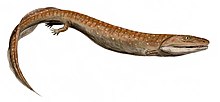Crassigyrinus
| Crassigyrinus Temporal range: Viséan
~ | |
|---|---|

| |
| 3D skull reconstruction | |
| Scientific classification | |
| Domain: | Eukaryota |
| Kingdom: | Animalia |
| Phylum: | Chordata |
| Clade: | Sarcopterygii |
| Clade: | Tetrapodomorpha |
| Clade: | Stegocephali |
| Family: | †Crassigyrinidae von Huene, 1948 |
| Genus: | †Crassigyrinus Watson, 1929 |
| Type species | |
| †Crassigyrinus scoticus Watson, 1929
| |
Crassigyrinus (from Latin: crassus, 'thick' and Greek: γυρίνος Greek: gyrínos, 'tadpole') is an extinct genus of carnivorous stem tetrapod from the Early Carboniferous Limestone Coal Group of Scotland and possibly Greer, West Virginia.[1]
Discovery
[edit]The type specimen was originally described as Macromerium scoticum and lacked a complete skull. With subsequent discoveries, Crassigyrinus is now known from three skulls, one of which is in articulation with a fairly complete skeleton, and two incomplete lower jaws. Crassigyrinus grew up to 2 meters in length, coupled with tiny limbs and unusually large jaws. Crassigyrinus is taxonomically enigmatic, having confused paleontologists for decades with its apparent fish-like and tetrapod features.[2] It was traditionally placed within the group Labyrinthodontia along with many other early tetrapods. Some paleontologists have even considered it as the most basal crown group tetrapod, while others hesitate to even place it within the Tetrapoda superclass.[citation needed]
Description
[edit]

Crassigyrinus had a streamlined body up to 2 meters in length. Its limbs were tiny and virtually useless, implying that the animal was almost completely aquatic. Crassigyrinus had unusually large jaws, equipped with two rows of sharp teeth, the second row having a pair of palatal fangs. Studies have shown that Crassigyrinus may have been able to open its mouth as wide as 60 degrees, which suggests that it was a powerful predator with a strong bite.[2] This strongly suggests that it was ideally suited for catching fish, and the animal was probably a fast-moving predator.

Several thickened bony ridges ran along the dorsal midline of the snout and between the eyes, and several paleontologists have suggested that they helped the skull to withstand stress when the animal bit prey. Crassigyrinus had large eyes, suggesting that it was either nocturnal, or lived in very murky water.[3] It possessed large otic (spiracular) notches, probably accommodating a spiracle rather than a tympanic membrane.[4]
Its peculiar stunted forelimbs were tiny and the humerus was only 35 mm long (the whole animal was about 1.5 m long). Various foramina on the humeral surfaces are very similar to those seen in Ichthyostega, Acanthostega, and lobe-finned fishes like Eusthenopteron.[5][6] The hindlimbs were much larger than the forelimbs, and in the pelvis the ilium lacked a bony connection to the vertebral column (a classic feature of aquatic tetrapods). Although there is evidence that the Crassigyrinus eventually lost its limbs,[7] there is counterevidence in that it used its limbs for movement,[8] as proven by healing in the bones in case of injury.[9] The fact that there is a need to heal the limbs must mean there was an importance of the limbs at some point, and was then lost. The tail, only known from a few vertebrae fragments, is assumed to have been long and laterally compressed.[2]
A crushed skull from the Dora bonebed near Cowdenbeath was described by Panchen (1985).[5] The skull was redescribed by Porro et al. (2023), based on a digital reconstruction derived from CT scans. The 1985 reconstruction of the skull was much taller and narrower than in most early tetrapods, though the 2023 reconstruction is relatively low and broad.[10]
Paleobiology
[edit]Crassygyrinus was an aquatic predator. It was capable of opening its jaws widely at a 60-degree angle, with a powerful bite with rapid jaw closure, allowing it to grasp and consume relatively large prey items.[10]
References
[edit]- ^ Godfrey, S. J. 1988. Isolated tetrapod remains from the Carboniferous of West Virginia. Kirtlandia 43, 27-36.
- ^ a b c Chapter on Crassigyrinus from Gaining ground: the origin and evolution of tetrapods, by Jennifer A. Clack, Indiana University Press 2002, from Google Books
- ^ Palmer, D., ed. (1999). The Marshall Illustrated Encyclopedia of Dinosaurs and Prehistoric Animals. London: Marshall Editions. p. 51. ISBN 1-84028-152-9.
- ^ Benton, 2005. Vertebrate Palaeontology 3rd edition. Blackwell Publishing
- ^ a b Panchen, A. L. 1985. On the amphibian Crassigyrinus scoticus Watson from the Carboniferous of Scotland. Philosophical Transactions of the Royal Society of London B 309, 505-568.
- ^ Panchen, A. L. 1991. The early tetrapods: classification and the shapes of cladograms. In Schultze, H.-P. & Trueb, L. (eds) Origins of the Higher Groups of Tetrapods, Controversy and Consensus. Comstock/Cornell University Press (Ithaca and London), pp. 110-144.
- ^ Caldwell, Michael W (2003-04-01). ""Without a leg to stand on": on the evolution and development of axial elongation and limblessness in tetrapods". Canadian Journal of Earth Sciences. 40 (4): 573–588. Bibcode:2003CaJES..40..573C. doi:10.1139/e02-081. ISSN 0008-4077.
- ^ Lennie, Kendra I.; Mansky, Chris F.; Anderson, Jason S. (2020-10-13). "New Crassigyrinus-like fibula from the Tournaisian (earliest Carboniferous) of Nova Scotia". Canadian Journal of Earth Sciences. 57 (11): 1365–1369. Bibcode:2020CaJES..57.1365L. doi:10.1139/cjes-2019-0128. S2CID 225160164.
- ^ Herbst, Eva C.; Doube, Michael; Smithson, Timothy R.; Clack, Jennifer A.; Hutchinson, John R. (September 2019). "Bony lesions in early tetrapods and the evolution of mineralized tissue repair". Paleobiology. 45 (4): 676–697. Bibcode:2019Pbio...45..676H. doi:10.1017/pab.2019.31. ISSN 0094-8373. S2CID 204145235.
- ^ a b Porro, Laura B.; Rayfield, Emily J.; Clack, Jennifer A. (2023-05-02). "Computed tomography and three-dimensional reconstruction of the skull of the stem tetrapod Crassigyrinus scoticus Watson, 1929". Journal of Vertebrate Paleontology. 42 (4): e2183134. doi:10.1080/02724634.2023.2183134. ISSN 0272-4634. S2CID 258475146.






